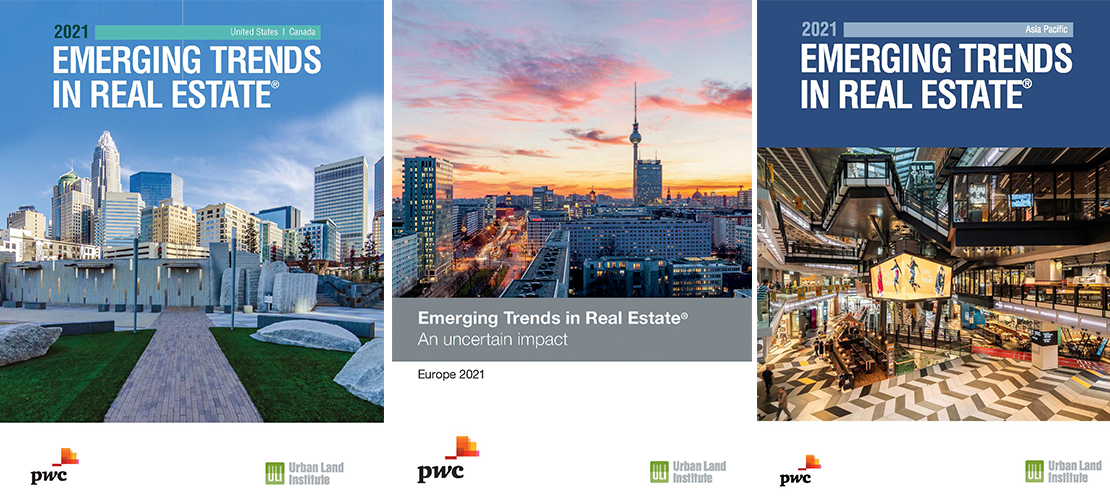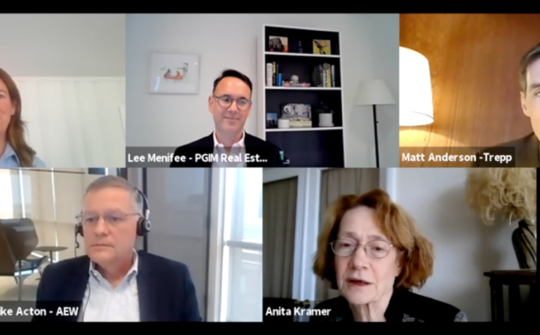In October 2020, the Urban Land Institute (ULI) and PwC US released Emerging Trends in Real Estate 2021, highlighting the evolving trends shaping the real estate industry. The report—which includes proprietary data and insights from more than 1,600 leading real estate industry experts—explores how COVID-19 accelerated many existing trends like retail footprint reductions, while it spawned new ones, such as an increased focus on social justice and health and wellness, and stopped others in their tracks like the appeal of big cities.
The report highlights how COVID-19 heightened the desirability of lower-density areas for both residential and commercial real estate, with interest concentrated in the Sunbelt markets. Cost-conscious companies will gravitate toward cities that are business-friendly and low cost with large, growing workforces. Raleigh/Durham, North Carolina, for example, is nicknamed the “Bay Area of the East Coast,” because of a surge in technology jobs and the area’s reputation as an education mecca. Homebuyers will look for suburban locations with low taxes, affordable housing, automobile-oriented transportation, and good job prospects. Growth in the suburbs has been a consistent trend since this report first predicted it five years ago; however, greater family formation among millennials and flexible work-from-home policies are boosting this shift.
Social unrest and protests in cities across the country have also played a role in the reevaluation of presence in urban cores. Seventy percent of respondents agree that the real estate industry can address and help end systemic racism—from promoting diversity, equity, and inclusion within the sector to looking for ways to develop underserved communities. On a rating scale of social issues in real estate, income and racial inequality moved from little to moderate importance last year, to moderate to great importance.
“Times of great change always present significant opportunities,” said W. Ed Walter, global CEO of ULI. “In the near term, our suburbs will benefit from new growth spurred by shifting demographics and changes to living and working patterns resulting from the COVID crisis. Our cities will have the opportunity to respond by reimagining their public realm, building more resiliently, and reinventing assets, such as retail, that were already struggling before the pandemic. As an industry, we have the opportunity to strengthen by truly embracing diversity and tackling the challenges faced by our communities.”
“Now, more than ever, the real estate industry has the chance to take the lead in using planning and development skills and investment capital to reshape our work and lifestyle environments. These tools can be used to address societal issues of safety, green space, and racial equity,” says Byron Carlock, PwC partner and U.S. Real Estate Practice leader. “The gauntlet of responsibility is ours to embrace, and industry leaders see the opportunities and are responding with investment and leadership.”
Now in its 42nd year, Emerging Trends in Real Estate is one of the most highly regarded annual industry outlooks for the real estate and land use industry. It includes interviews and survey responses from 1,687 leading real estate experts, including investors, fund managers, developers, property companies, lenders, brokers, advisers, and consultants.
Download Emerging Trends in Real Estate from Knowledge Finder.

Europe
Europe’s property sector is in the midst of a cyclical downturn that is coinciding with long-term structural changes in real estate, according to the 18th edition of the Emerging Trends in Real Estate Europe report, released in November 2020. However, real estate generally is viewed as one of the few asset classes to generate acceptable returns at a time of low or negative interest rates.
The PwC and ULI survey of almost 1,000 industry leaders across Europe indicates that retail space and offices will be the sectors most affected because of widespread uncertainty related to rent collections amid the pandemic. This factor has led investors increasingly to assess the underlying operational risk of the occupiers and focus on their own strengths as operators of real estate to keep the income secured.
Capital flows into the sector are also altering how funds can be deployed, and a strong likelihood exists that domestic and European investors will play a much greater role in Europe. Although a majority of those surveyed still expect the amount of Asian capital flowing into Europe to increase, this percentage is significantly lower than in previous years, with interviewees citing the inability of overseas investors to visit a property in Europe before buying it.
The challenges related to business travel and potential future lockdowns are raising concerns about deal sourcing. The industry had been working through a pipeline of deals originated prepandemic, subject to conventional due diligence and mostly with existing partners.
However, the assessment of new opportunities within restrictions and the difficulty of building new relationships in a Zoom era might significantly slow the transaction volume further going forward. At the same time, this situation could provide an advantage to those players with a larger footprint—those with resources in place on the ground in more countries—as well as the real estate markets in the bigger countries, such as Germany, that offer sufficient critical mass and the possibility to travel domestically and overcome some of the restrictions.
The “digital switch”—the increased pace of digitalization around the globe, boosted by COVID-19—is also affecting investors’ sector preferences, with logistics, data centers, and communication towers and fiber identified as having strong potential. In addition, investors are looking favorably on life sciences and health care, a trend accelerated by the pandemic, as is the residential sector.
“European real estate is at a turning point, trying to work out its future role in society while facing the cyclical challenges following the outbreak of the pandemic earlier this year and the ongoing uncertainty this creates,” said Lisette van Doorn, chief executive officer of ULI Europe. “COVID-19 has fast-forwarded a number of trends already started—for example, related to digitalization, remote work, and online shopping. But given the artificial environment amidst ongoing lockdowns and government support to employees and businesses, it remains hard to work out the long-term impact.
“The search for yield, which is now even more dominant than pre-COVID, continues to attract investors to real estate, especially core and income generating, such as residential that continues to appeal to investors, in the ‘safest havens’ across Europe,” she said.
“The pandemic has amplified a number of previously identified structural trends,” said Gareth Lewis, real estate director at PwC U.K. “These include the uptick in e-commerce and remote working, causing investors and the industry at large to reexamine the historical risk-and-return profile for many types of real estate. It’s clear that at this time of significant uncertainty, investors continue to see Europe’s core cities as safer bets, and there remains cautious optimism.
“With London jumping up two places to second in the rankings—despite the challenges faced by all major cities—many investors see the long-term value. Further, central banks’ decisions to depress interest rates for the foreseeable [future] may [lead to] an uptick in investment activity as pent-up capital is deployed.”
“The uncertainty of this year has shifted priorities in the sector,” said Simon Hampton, real assets leader at PwC U.K. “We’ve seen a move away from the mainstay sectors of retail, hospitality, and leisure; a pause in relation to office; a strengthening demand for alternative sectors, such as housing, data centers, life sciences/health, energy, and communications infrastructure; and a continued desire for industrial property and logistics warehouses—which all benefit from growing demand in this new environment.”
He continued: “There’s a growing requirement to look more closely at the value that can be derived from these demand shifts and newer, emerging asset classes. Investors in the sector are therefore looking beyond real estate and into broader real assets—the built environment and infrastructure that surrounds us. These are all inextricably linked, not only to one another, but to how we live, work, consume, and spend our leisure time.”
“The real estate industry faces a uniquely challenging period combining a potential recession in the immediate term and a series of structural challenges in the medium term,” said Angus Johnston, real estate leader at PwC U.K. “Both are likely to lead to changes to the use and value of our existing stock of real estate. How these challenges play out and how the industry responds to them will define the future shape of our sector.”
The report, published annually by ULI and PwC, is based on the opinions of 995 real estate professionals across Europe, including investors, developers, lenders, and advisers.
Asia Pacific
Although the success of Asia Pacific governments in containing the spread of COVID-19 has helped limit its impact on local real estate markets, there are growing concerns that a correction may be in the cards next year, according to the 2021 Emerging Trends in Real Estate Asia Pacific report, released in November 2020. The 15th edition of this regional real estate forecast report is jointly published by ULI—the world’s oldest and largest network of cross-disciplinary real estate and land use experts—and PwC.
The report names three markets where stress seems likely to surface. First is China, where a liquidity squeeze is creating bank financing challenges for smaller developers. Second is India, where the implosion of local nonbank finance companies has created opportunities for foreign private equity funds. And third is Australia, where the economic impact has been most acute and greater market transparency is likely to open up more buying prospects.
Singapore, Tokyo, and Sydney continue to rank as the top three markets for investment and development prospects in the region. These markets each promise a sense of safe harbor in an increasingly hostile global environment, in both geopolitical and economical risks. Seoul rose steeply in this year’s investment prospects rankings as South Korea enjoys the benefit of a deep domestic economy that allows assets to be brought or built with a view toward serving domestic demand rather than outwardly facing geopolitical risk. Ho Chi Minh City is once again viewed as the sole emerging market city with the best prospects for growth, boosted by its successful containment of the pandemic and a rapidly growing economy spurred by the escalating China/ U.S. trade tensions.
David Faulkner, president of ULI Asia Pacific, said: “The Asia Pacific region has been remarkably resilient to the challenges faced by coronavirus, particularly compared with Western markets, but we expect to see some market correction. Despite the common rhetoric that the pandemic has ignited many changes to our society, what we have seen so far in the real estate sector is an acceleration of trends already underway before the arrival of COVID-19. ESG [environmental, social, and governance] themes are one example of this, as is a movement by developers toward designing general-purpose structures that can be adapted to serve multipurposes over their lifetimes.”
Said KK So, Asia Pacific real estate tax leader, PwC, “2020 has certainly been a challenging year for Asia Pacific real estate, witnessing a steep decline in transaction volumes. However, investors in the region remain nimble and are already grasping opportunities emerging from the crisis. While remaining focused on mainstream asset classes, they are also looking at other sources of reliable income streams in a down-trending market.”
The report highlights logistics as the asset class that will probably emerge from the pandemic strongest as it continues to witness sustained demand, pushed by a number of cyclical and structural drivers, in particular the robust growth in e-commerce. Meanwhile, residential sectors in the Asia Pacific region have remained surprisingly resilient to the impact of COVID-19, despite threats of economic downturns. In an environment of uncertainty, this upbeat consumer sentiment—together with an equally reliable long-term mortgage and rent payment track record—earmarks the residential sector as a defensive asset class that investors in the region are now targeting.
The report cited some other trends of note:
- Asian companies are divesting real estate corporate assets in the form of sale-and-leaseback transactions.
- Positive signs point to the growing demand for green debt in the Asia Pacific region.
- Respondents in the Asia Pacific region tend to be less in favor of a long-term work-from-home trend.
- Travel bans have affected markets with more international investors, such as Australia.
- Buyers and sellers have reached a standoff over asset pricing.
- Hot desking may soon be a thing of the past.
The Emerging Trends Asia Pacific report is based on a survey of 391 real estate professionals, as well as 134 interviews, including investors, developers, property company representatives, lenders, brokers, and consultants.


